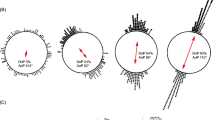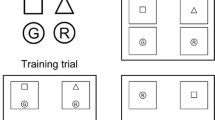Summary
The present experiment compared the establishment of a position habit and three subsequent response shifts with and without discriminative stimuli. The discriminative stimuli employed were (a) 90° and 180° polarization patterns and (b) high and low intensity levels. A significant difference (0.05) was found between the running time performance of the polarization discrimination group and the uniform illumination and bright-dark discrimination groups. No similar difference was found with errors as the dependent measure, and no significant between group differences were found during the response shifts. The conclusion was drawn that the extra-ocular hypothesis could not account for the significant difference.
Similar content being viewed by others
References
Autrum, H., u. H. Stumpf: Das Bienenauge als Analysator für polarisiertes Licht. Z. Naturforsch. 5b, 116–122 (1950) (Biol. Abstr. 28, 2424).
Bainbridge, R., and T.H. Waterman: Polarized light and the orientation of two marine crustacea. J. exp. Biol. 35, 487–498 (1958).
Baylor, E.R.: The responses of snails to polarized light. J. exp. Biol. 36, 369–376 (1959).
—, and F.E. Smith: The orientation of Cladocera to polarized light. Amer. Naturalist 87, 97–101 (1953).
- - Diurnal migration of plankton crustaceans. In: Recent advances in invertebrate physiology, p. 21–36. University of Oregon Press 1957. Cit. by E. R. Baylor, The responses of snails to polarized light. J. exp. Biol. 36, 369–376 (1959).
Burdon-Jones, C., and G.H. Charles: Light reactions of littoral gastropods. Nature (Lond.) 81, 129–131 (1958).
Daumer, K., R. Jander, and T.H. Waterman: Orientation of the ghost crab ocypode in polarized light. Z. vergl. Physiol. 47, 56–76 (1963).
Fernández-Moran, H.: Fine strucutures of the light receptors in the compound eye of insects. Exp. Cell. Res. Suppl. 5, 586–599 (1958).
Görner, P.: Die Orientierung der Trichterspinne nach polarisiertem Licht. Z. vergl. Physiol. 45, 307–314 (1962).
Kalmus, H.: Responses of insects to polarized light in the presence of dark reflecting surfaces. Nature (Lond.) 182, 1526–1527 (1958).
—: Orientation of animals to polarized light. Nature (Lond.) 184, 228–230 (1959).
Moody, M.E.: Evidence for the intraocular discrimination of vertically and horizontally polarized light by octopus. J. exp. Biol. 39, 21–30 (1962).
Papi, F.: Ricerche sull' orientamento astronomic di Arctosa perita. Publ. Staz. zool. Napoli 27, 80–104 (1955).
Smith, F.E., and E.R. Baylor: Bees, daphnia, and polarized light. Ecology 41, 360–363 (1960).
Stevens, G.C., M. Fingerman, and F.A. Brown: The orientation of Drosophila to plane polarized light. Ann. entomol. Soc. Amer. 46, 75–83 (1953).
Waterman, T.H.: Interaction of polarized light and turbidity in the orientation of Daphnia and Mysidium. Z. vergl. Physiol. 44, 268–291 (1959).
Author information
Authors and Affiliations
Additional information
This paper is taken from a Master's Thesis submitted to the Florida State University by the senior author, under the direction of the junior author, in partial fulfillment of the requirements for the degree of Master of Science. A portion of this paper was presented at the 1965 meeting of the American Psychological Association.
This research was partially supported by a grant from the Florida State University Research Council. The statistical analyses were made possible in part by a National Science Foundation grant (# GP 671) to the Florida State University Computation Center. The authors are indebted to Dr. F. J. King, Institute of Human Learning, Florida State University, for his contribution to the data analysis.
Rights and permissions
About this article
Cite this article
Henton, W.W., Crawford, F.T. The discrimination of polarized light by the tarantula. Zeitschrift für vergleichende Physiologie 52, 26–32 (1966). https://doi.org/10.1007/BF00343655
Received:
Issue Date:
DOI: https://doi.org/10.1007/BF00343655




